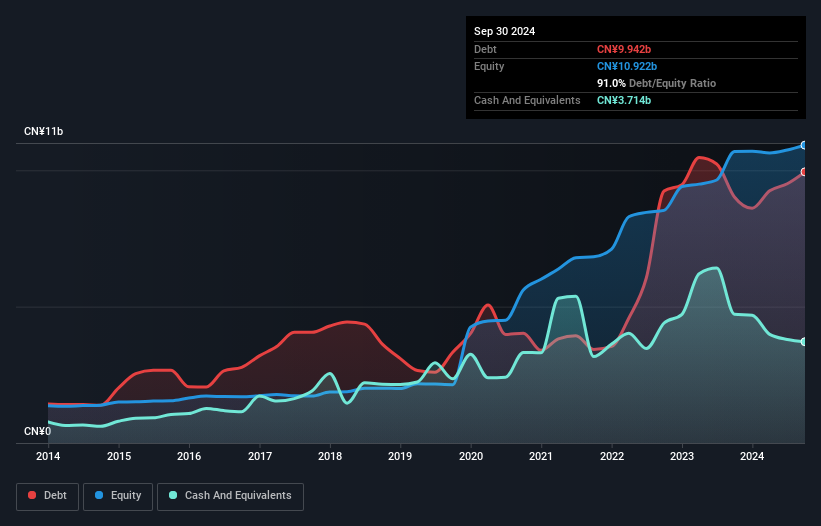Legendary fund manager Li Lu (who Charlie Munger backed) once said, 'The biggest investment risk is not the volatility of prices, but whether you will suffer a permanent loss of capital.' When we think about how risky a company is, we always like to look at its use of debt, since debt overload can lead to ruin. Importantly, Hefei Urban Construction Development Co., Ltd (SZSE:002208) does carry debt. But the more important question is: how much risk is that debt creating?
When Is Debt Dangerous?
Debt assists a business until the business has trouble paying it off, either with new capital or with free cash flow. If things get really bad, the lenders can take control of the business. However, a more common (but still painful) scenario is that it has to raise new equity capital at a low price, thus permanently diluting shareholders. Having said that, the most common situation is where a company manages its debt reasonably well - and to its own advantage. The first step when considering a company's debt levels is to consider its cash and debt together.
What Is Hefei Urban Construction Development's Debt?
As you can see below, at the end of September 2024, Hefei Urban Construction Development had CN¥9.94b of debt, up from CN¥9.02b a year ago. Click the image for more detail. However, it also had CN¥3.71b in cash, and so its net debt is CN¥6.23b.

How Healthy Is Hefei Urban Construction Development's Balance Sheet?
 Zooming in on the latest balance sheet data, we can see that Hefei Urban Construction Development had liabilities of CN¥20.8b due within 12 months and liabilities of CN¥6.20b due beyond that. On the other hand, it had cash of CN¥3.71b and CN¥3.75b worth of receivables due within a year. So its liabilities total CN¥19.5b more than the combination of its cash and short-term receivables.
Zooming in on the latest balance sheet data, we can see that Hefei Urban Construction Development had liabilities of CN¥20.8b due within 12 months and liabilities of CN¥6.20b due beyond that. On the other hand, it had cash of CN¥3.71b and CN¥3.75b worth of receivables due within a year. So its liabilities total CN¥19.5b more than the combination of its cash and short-term receivables.
This deficit casts a shadow over the CN¥7.45b company, like a colossus towering over mere mortals. So we'd watch its balance sheet closely, without a doubt. After all, Hefei Urban Construction Development would likely require a major re-capitalisation if it had to pay its creditors today.
In order to size up a company's debt relative to its earnings, we calculate its net debt divided by its earnings before interest, tax, depreciation, and amortization (EBITDA) and its earnings before interest and tax (EBIT) divided by its interest expense (its interest cover). The advantage of this approach is that we take into account both the absolute quantum of debt (with net debt to EBITDA) and the actual interest expenses associated with that debt (with its interest cover ratio).
Hefei Urban Construction Development's net debt to EBITDA ratio is 6.1 which suggests rather high debt levels, but its interest cover of 7.7 times suggests the debt is easily serviced. Our best guess is that the company does indeed have significant debt obligations. We note that Hefei Urban Construction Development grew its EBIT by 30% in the last year, and that should make it easier to pay down debt, going forward. The balance sheet is clearly the area to focus on when you are analysing debt. But it is Hefei Urban Construction Development's earnings that will influence how the balance sheet holds up in the future. So when considering debt, it's definitely worth looking at the earnings trend. Click here for an interactive snapshot.
But our final consideration is also important, because a company cannot pay debt with paper profits; it needs cold hard cash. So we clearly need to look at whether that EBIT is leading to corresponding free cash flow. Over the last three years, Hefei Urban Construction Development saw substantial negative free cash flow, in total. While that may be a result of expenditure for growth, it does make the debt far more risky.
Our View
To be frank both Hefei Urban Construction Development's conversion of EBIT to free cash flow and its track record of staying on top of its total liabilities make us rather uncomfortable with its debt levels. But on the bright side, its EBIT growth rate is a good sign, and makes us more optimistic. Overall, it seems to us that Hefei Urban Construction Development's balance sheet is really quite a risk to the business. So we're almost as wary of this stock as a hungry kitten is about falling into its owner's fish pond: once bitten, twice shy, as they say. When analysing debt levels, the balance sheet is the obvious place to start. But ultimately, every company can contain risks that exist outside of the balance sheet. For example, we've discovered 6 warning signs for Hefei Urban Construction Development (4 don't sit too well with us!) that you should be aware of before investing here.
If, after all that, you're more interested in a fast growing company with a rock-solid balance sheet, then check out our list of net cash growth stocks without delay.
Have feedback on this article? Concerned about the content? Get in touch with us directly. Alternatively, email editorial-team (at) simplywallst.com.
This article by Simply Wall St is general in nature. We provide commentary based on historical data and analyst forecasts only using an unbiased methodology and our articles are not intended to be financial advice. It does not constitute a recommendation to buy or sell any stock, and does not take account of your objectives, or your financial situation. We aim to bring you long-term focused analysis driven by fundamental data. Note that our analysis may not factor in the latest price-sensitive company announcements or qualitative material. Simply Wall St has no position in any stocks mentioned.

